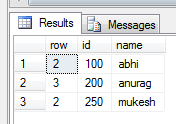December 26, 2013
Grouping,Grouping Set,Grouping_Id how interesting it is
create table #temp1
(
id int,
year1 int,
count1 int
)
--drop table
#temp1
insert into #temp1 values (1,2001,200)
insert into #temp1 values (1,2001,500)
insert into #temp1 values (1,2001,300)
insert into #temp1 values (1,2002,500)
insert into #temp1 values (1,2002,300)
insert into #temp1 values (1,2003,500)
insert into #temp1 values (1,2003,300)
insert into #temp1 values (2,2001,200)
insert into #temp1 values (2,2001,700)
insert into #temp1 values (2,2002,1100)
insert into #temp1 values (2,2002,200)
insert into #temp1 values (2,2002,700)
insert into #temp1 values (2,2002,1100)
insert into #temp1 values (2,2003,200)
insert into #temp1 values (2,2003,700)
insert into #temp1 values (2,2003,1100)
insert into #temp1 values (3,2001,500)
insert into #temp1 values (3,2001,1500)
insert into #temp1 values (3,2001,1000)
insert into #temp1 values (3,2001,500)
insert into #temp1 values (3,2002,1500)
insert into #temp1 values (3,2002,1000)
insert into #temp1 values (3,2003,500)
insert into #temp1 values (3,2003,1500)
insert into #temp1 values (3,2003,1000)
-------------------------------------------------------------------------
select id,year1,sum(count1)
from #temp1
group by id,year1
with rollup
-----------------------------------------------------------------------------
WITH CUBE
select id,year1,sum(count1)
from #temp1
group by id,year1
with cube
-------------------------------------------------------------------------
select id,year1,sum(count1)
from #temp1
group by grouping sets((id,year1),())
--------------------------------------------------------------------------
select
case when grouping(id)=0 then id
else 100 end as id,
year1,sum(count1)
from #temp1
group by grouping sets((id,year1),())
--------------------------------------------------------------
select id,
case when
grouping_id(id,year1)=0
then year1
when
grouping_id(id,year1)=1
then 100
when
grouping_id(id,year1)=3
then 300 end as year1,
sum(count1),
grouping(id) as grouping_id1,
grouping(year1)as grouping_year1,
grouping_id(id,year1) as grouping_id_column
from #temp1
group by id,year1
with rollup




















